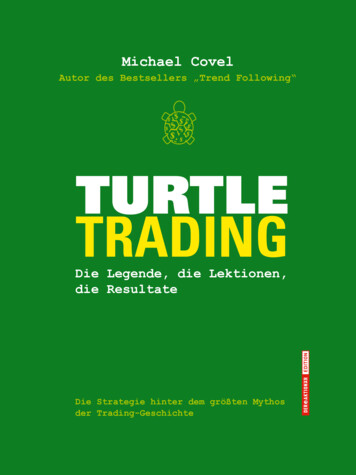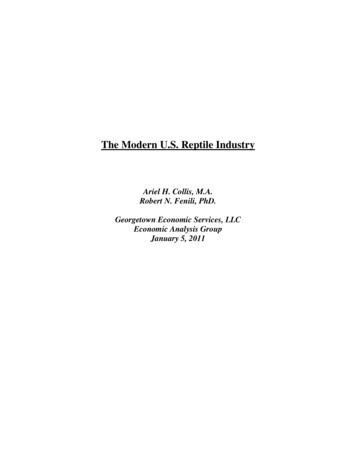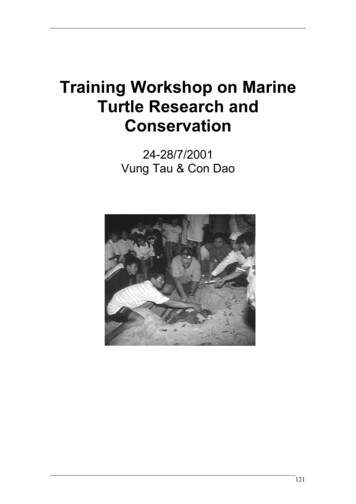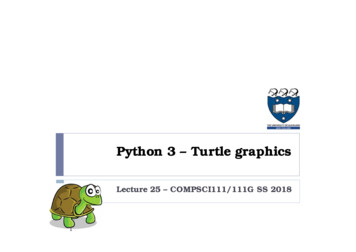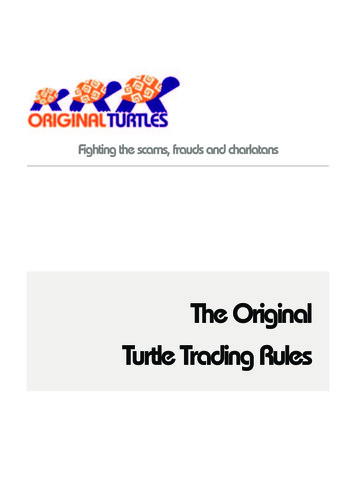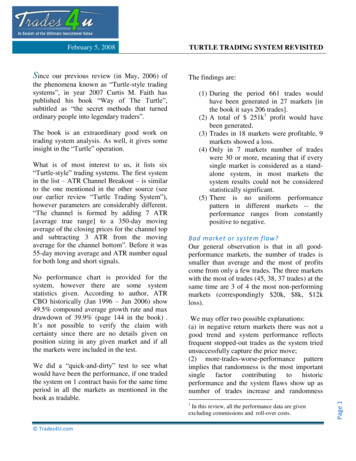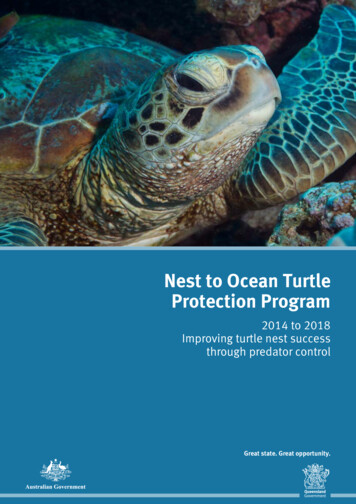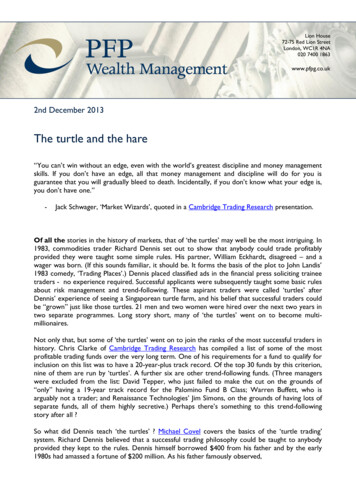
Transcription
Lion House72-75 Red Lion StreetLondon, WC1R 4NA020 7400 1863www.pfpg.co.uk2nd December 2013The turtle and the hare“You can’t win without an edge, even with the world’s greatest discipline and money managementskills. If you don’t have an edge, all that money management and discipline will do for you isguarantee that you will gradually bleed to death. Incidentally, if you don’t know what your edge is,you don’t have one.”-Jack Schwager, ‘Market Wizards’, quoted in a Cambridge Trading Research presentation.Of all the stories in the history of markets, that of ‘the turtles’ may well be the most intriguing. In1983, commodities trader Richard Dennis set out to show that anybody could trade profitablyprovided they were taught some simple rules. His partner, William Eckhardt, disagreed – and awager was born. (If this sounds familiar, it should be. It forms the basis of the plot to John Landis’1983 comedy, ‘Trading Places’.) Dennis placed classified ads in the financial press soliciting traineetraders - no experience required. Successful applicants were subsequently taught some basic rulesabout risk management and trend-following. These aspirant traders were called ‘turtles’ afterDennis’ experience of seeing a Singaporean turtle farm, and his belief that successful traders couldbe “grown” just like those turtles. 21 men and two women were hired over the next two years intwo separate programmes. Long story short, many of ‘the turtles’ went on to become multimillionaires.Not only that, but some of ‘the turtles’ went on to join the ranks of the most successful traders inhistory. Chris Clarke of Cambridge Trading Research has compiled a list of some of the mostprofitable trading funds over the very long term. One of his requirements for a fund to qualify forinclusion on this list was to have a 20-year-plus track record. Of the top 30 funds by this criterion,nine of them are run by ‘turtles’. A further six are other trend-following funds. (Three managerswere excluded from the list: David Tepper, who just failed to make the cut on the grounds of“only” having a 19-year track record for the Palomino Fund B Class; Warren Buffett, who isarguably not a trader; and Renaissance Technologies’ Jim Simons, on the grounds of having lots ofseparate funds, all of them highly secretive.) Perhaps there’s something to this trend-followingstory after all ?So what did Dennis teach ‘the turtles’ ? Michael Covel covers the basics of the ‘turtle trading’system. Richard Dennis believed that a successful trading philosophy could be taught to anybodyprovided they kept to the rules. Dennis himself borrowed 400 from his father and by the early1980s had amassed a fortune of 200 million. As his father famously observed,
“Let’s just say Richie ran that 400 up pretty good.”The basic ‘turtle’ rules involved entering trades on the basis of markets breaking out frompreviously established ranges. If a given futures market traded at a new 20-day high, then it shouldbe bought. If it traded at a new 20-day low, it should be sold. Stop losses were included forhedging downside risk. Risk per transaction was also carefully controlled. ‘The turtles’ wereallowed to trade a variety of US futures markets, including interest rates, currencies, energies,metals and commodities (hard and soft). Futures markets were favoured due to their depth andliquidity. Whereas most fund managers try and predict the future, ‘the turtles’ simply paidattention to the market price. For as long as price trends persisted and they weren’t stopped out,they would add to their positions (subject to obeying the rules about appropriate position sizing).If ‘the turtles’ lost money, they would have to reduce their bet size until they’d brought theiraccount back into the black.There are really only two ways of looking at financial markets. One of them is fundamental: totake into consideration macro-economic themes, the economy, interest rates, inflation. The otheris technical: what are prices doing ? The City tends to favour fundamental analysis; the problemhere being that fundamental analysis is inherently subjective. The reality, which Dennis recognised,is that price is the only metric really worth trusting – everything else is a matter of opinion. Thistrading strategy today goes by the name ‘systematic trend-following’. Unlike many approaches totrading, it requires no special understanding of any given market – just a healthy respect for theprice action. And there are two specific reasons why we look favourably on systematic trendfollowing funds. One is that they have a long history of generating attractive returns. The second isthat whatever their future return streams, those returns can be confidently expected to comewith roughly zero correlation to the stock market. Which makes them the perfect investmentvehicle to sit within a properly diversified portfolio alongside the likes of stocks, bonds and realassets.Systematic (i.e. non-discretionary) trend-following funds have had a disappointing run over the lastcouple of years, leading some to suspect that the model is broken. Put in a longer term context,recent disappointing returns are nothing that the industry hasn’t seen before. AQR CapitalManagement recently published a research note ‘A century of evidence on trend-followinginvesting’ which modelled a simple time series momentum strategy across a number of assetclasses, from January 1903 to June 2012. To be realistic, they made deductions for transactioncosts and fund management fees. The results are shown below.Source: AQR.
AQR also plotted the returns of this simple time series momentum strategy against the returns ofa 60/40 portfolio (with 60% of the portfolio invested in the S&P 500 equity index and 40% investedin 10 year US government bonds, rebalanced back to 60/40 at the end of each month, and with nofees or transaction costs deducted from the portfolio’s returns). Those results are shown below.Note that in 9 of the 10 worst drawdowns for the 60/40 (“conventional”) portfolio over the lastcentury, the naïve trend-following portfolio made a positive return. This itself is a variation on amore recent theme, as shown in Barclay Hedge data covering actual trend-following funds (thedark blue bars below) during the worst periods for the US equity markets (the light blue areasbelow) since 1987. In all of those bear market experiences, trend-followers made money.AQR concede that“Following very strong performance in 2008, trend-following strategies have experienced a fewdrawdowns [peak to trough declines] from 2009-2012.”
Does this mean that the strategy is broken or that the current environment is one in which trendfollowing no longer “works” ? They also published data covering the 10 largest drawdowns fromtheir hypothetical century-long model:Their assessment ?“When evaluated in this long-term context, the drawdowns experienced within the past threeyears do not look unusually large. While recent strategy performance has been disappointing, wedo not find any evidence that the recent environment has been anomalously poor for the strategyrelative to history.”Or in other words, we are seeing nothing today that we haven’t seen before, or will again. Forsystematic trend-following funds to “work” requires ultimately just two things, in our view: greedand fear on the part of other investors. As the market oscillates between those two extremes,prices form trends, the direction and intensity of which reflect which emotion has the upper handover investors’ psychology. Increased assets under management by the industry may also haveplayed a role in recent performance, but we find it difficult to believe that that role is really life(or performance-) threatening. Barclay Hedge estimate that assets managed by systematic trendfollowers account have grown to or over approximately 260 billion as at 2012. If that sounds likea lot, it is just over half the market capitalisation of Apple Inc.There are other reasons to find systematic trend-following appealing. If macro fundamentals wereever easy to read, they are almost impossible to read now. The extent of central bankintervention and attendant distortion of asset prices is off the charts. In trying to navigate thesetreacherous markets, trend-followers with sound risk management seem like ideal companions tous. Unlike conventional fund managers, these traders pursue strategies that are immune toemotion and the vagaries of market forecasting and herd thinking: they simply trade the price,whatever it is.Tim PriceDirector of InvestmentPFP Wealth Management2nd December 2013.Follow me on twitter: timfprice
Email: tim.price@pfpg.co.ukWeblog: http://thepriceofeverything.typepad.comImportant Note:PFP has made this document available for your general information. You are encouraged to seek advice before acting on the information, eitherfrom your usual adviser or ourselves. We have taken all reasonable steps to ensure the content is correct at the time of publication, but may havecondensed the source material. Any views expressed or interpretations given are those of the author. Please note that PFP is not responsible forthe contents or reliability of any websites or blogs and linking to them should not be considered as an endorsement of any kind. We have nocontrol over the availability of linked pages. PFP Group - no part of this document may be reproduced without the express permission of PFP.PFP Wealth Management is authorised and regulated by the Financial Conduct Authority, registered number 473710. Ref 1057/13/JB 281113.
The basic 'turtle' rules involved entering trades on the basis of markets breaking out from previously established ranges. If a given futures market traded at a new 20-day high, then it should be bought. If it traded at a new 20-day low, it should be sold. Stop losses were included for hedging downside risk.




